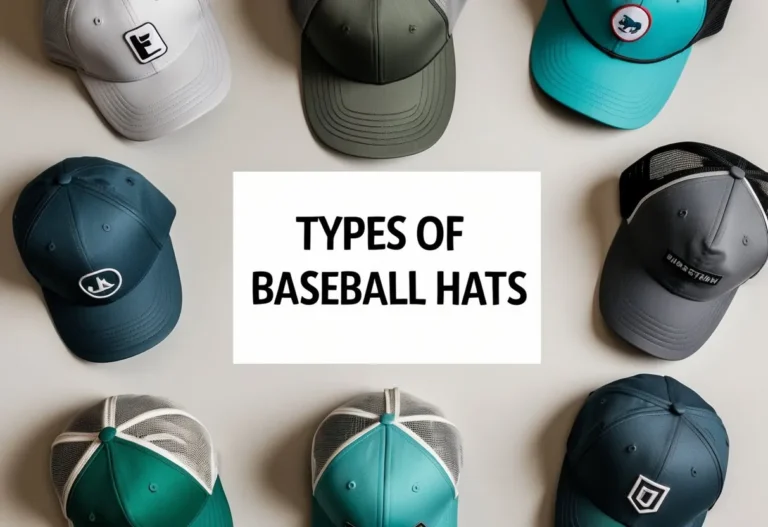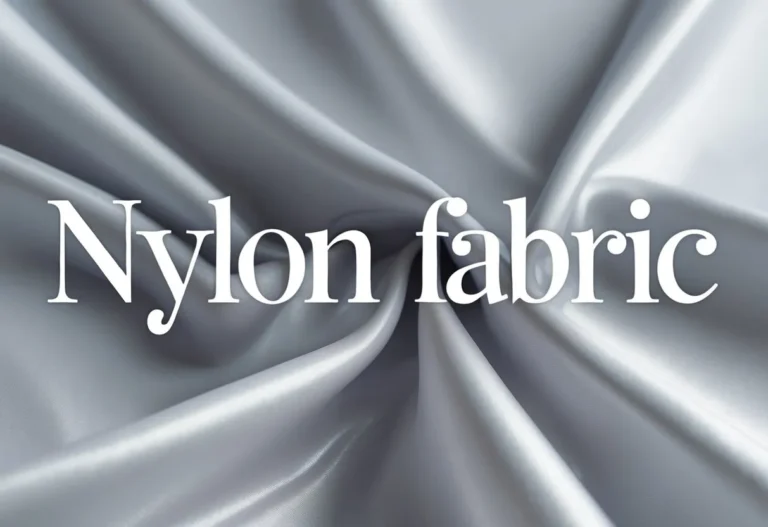People often confuse Sweater vs Sweatshirt because both are common warm tops worn in colder weather. They share some similarities, but each has unique features that make them suitable for different occasions and uses.
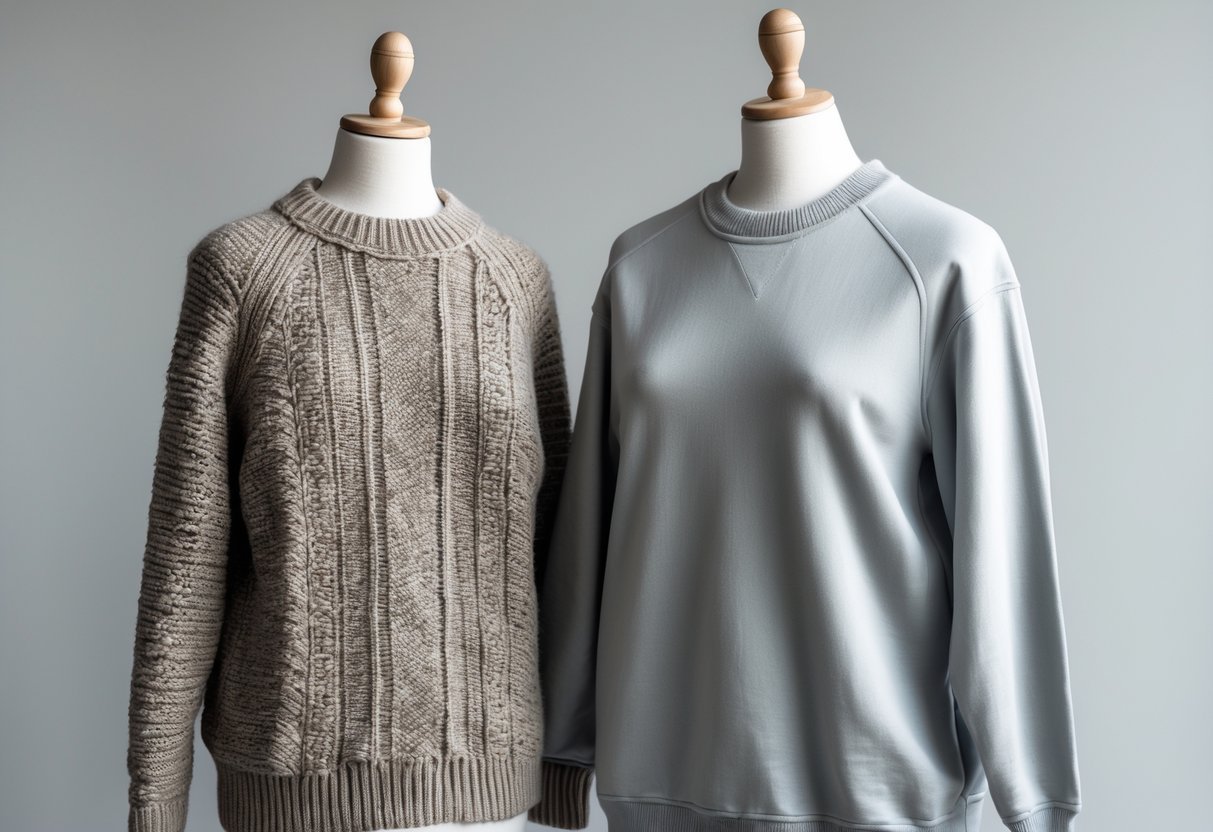
The main difference between a sweater and a sweatshirt lies in their material, design, and the level of formality they offer. Understanding these differences helps people choose the right clothing for comfort, style, and function.
1) Material Differences

Sweaters are usually made from knitted fibers like wool or cotton. The knitting process creates loops of yarn that give sweaters their stretch and texture. This method also helps trap heat while allowing some airflow, keeping the wearer warm without too much sweating.
Sweatshirts, on the other hand, are made from fleece or cotton jersey fabric. These fabrics are thicker and often have a soft, fuzzy inside called fleece. This inner layer is designed to keep warmth close to the body by trapping air.
The outer fabric of sweatshirts is smooth, making them comfortable and casual to wear. Unlike sweaters, which rely on knitting, sweatshirts are made from woven or knitted materials but focus more on warmth through their thick, soft lining.
The difference in materials affects how each garment feels and functions. Sweaters tend to be lighter and more breathable, while sweatshirts offer extra warmth and softness, often suited for sports or casual use.
2) Formality

Sweaters are made from finer materials like wool, cotton blends, or cashmere. This makes them look more polished and appropriate for business casual environments. They often have a tailored or fitted design, which helps create a neat appearance.
Sweatshirts are usually made from cotton jersey with a fleece backing. They have a more relaxed, sporty look. Because of this, sweatshirts are best suited for casual or athletic wear, not office settings.
In business casual styles, sweaters can be layered under blazers or worn alone with dress pants or skirts. This adds a formal touch without being too stiff.
Sweatshirts lack these formal qualities and usually do not pair well with traditional business clothing. They are more comfortable but less professional in appearance.
Choosing a fine-knit sweater in neutral colors like gray, black, or navy helps maintain a balanced, work-appropriate look. Sweatshirts, even in solid colors, rarely achieve this level of formality.
3) Warmth Level

Sweaters are usually made with thick knitted fabric. This knitting creates a dense structure that traps heat well. Because of this, sweaters tend to keep the body warmer in cold weather.
Sweatshirts, on the other hand, are made from jersey fleece or cotton blends. These materials are softer and lighter but not as thick as sweater knits. Sweatshirts offer warmth but are often less insulating than sweaters.
The knit patterns in sweaters add extra layers of fabric. This helps block cold air and retain body heat. Sweatshirts focus more on comfort and breathability, making them better for mild or cool temperatures rather than very cold conditions.
In short, sweaters generally provide more warmth due to their heavier, knitted construction. Sweatshirts work well for casual warmth but do not match sweaters in insulating ability.
4) Fit and Design

Sweaters tend to have a more tailored fit. They often hug the body and create a smooth, slim look. This is common in dressier sweaters made from finer fabrics like wool or cashmere.
Sweatshirts have a relaxed, looser fit. They are designed for comfort and casual wear, often giving a sporty or laid-back vibe. Their shape is generally boxier compared to sweaters.
Design-wise, sweaters offer more variety. They come in different textures, patterns, and shapes. Sweatshirts usually have simpler designs, often with added features like hoods or pockets.
The knit fabric of sweaters allows them to contour the body gently. Sweatshirts use thicker, soft materials like fleece, making them ideal for warmth and ease of movement.
The difference in fit and design reflects each garment’s purpose. Sweaters lean toward formal or smart-casual uses. Sweatshirts are geared more for casual, athletic, or lounge wear.
5) Purpose

Sweaters focus on providing warmth while adding a touch of style. They are often worn in settings where a more polished look is desired. The fabrics and knitting patterns used give sweaters a textured and refined appearance.
Sweatshirts, on the other hand, prioritize comfort above all else. They are made with soft, thick fabrics like fleece or cotton blends. This makes sweatshirts ideal for casual wear, lounging, or physical activities.
While sweaters can work well for both casual and dressy occasions, sweatshirts are usually reserved for relaxed, informal settings. This difference in purpose shapes how each garment is used and paired with other clothing.
In short, sweaters offer a balance of warmth and style, suited for multiple occasions. Sweatshirts emphasize ease and comfort, fitting best in laid-back environments.
6) Care Instructions
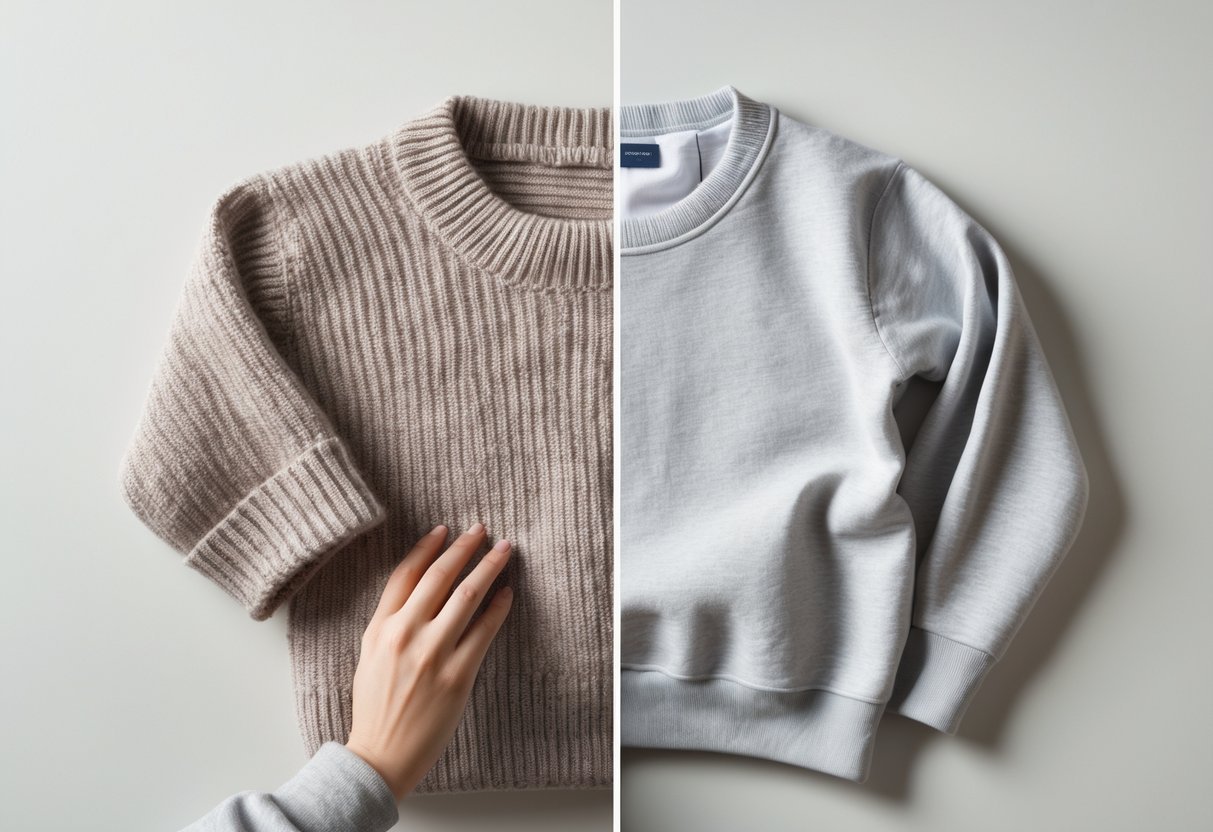
Sweaters usually need more careful cleaning because of their delicate fibers. Many sweaters, especially those made from wool, cashmere, or other fine materials, should be hand washed or dry cleaned to avoid damage.
Machine washing sweaters can sometimes cause shrinking, stretching, or loss of shape. If machine washing is allowed, it should be done on a gentle or delicate cycle using cold water. Using a mesh laundry bag helps protect sweaters from friction.
Sweatshirts are much easier to care for. Most sweatshirts are made from cotton or polyester blends, which can be safely machine washed on regular cycles. They do not usually require special handling or dry cleaning.
Drying methods differ too. Sweaters often need to be laid flat to dry to keep their shape. Sweatshirts can generally be tumble dried without issue.
Following these care instructions helps maintain the look and fit of each garment over time.
7) Common Styles
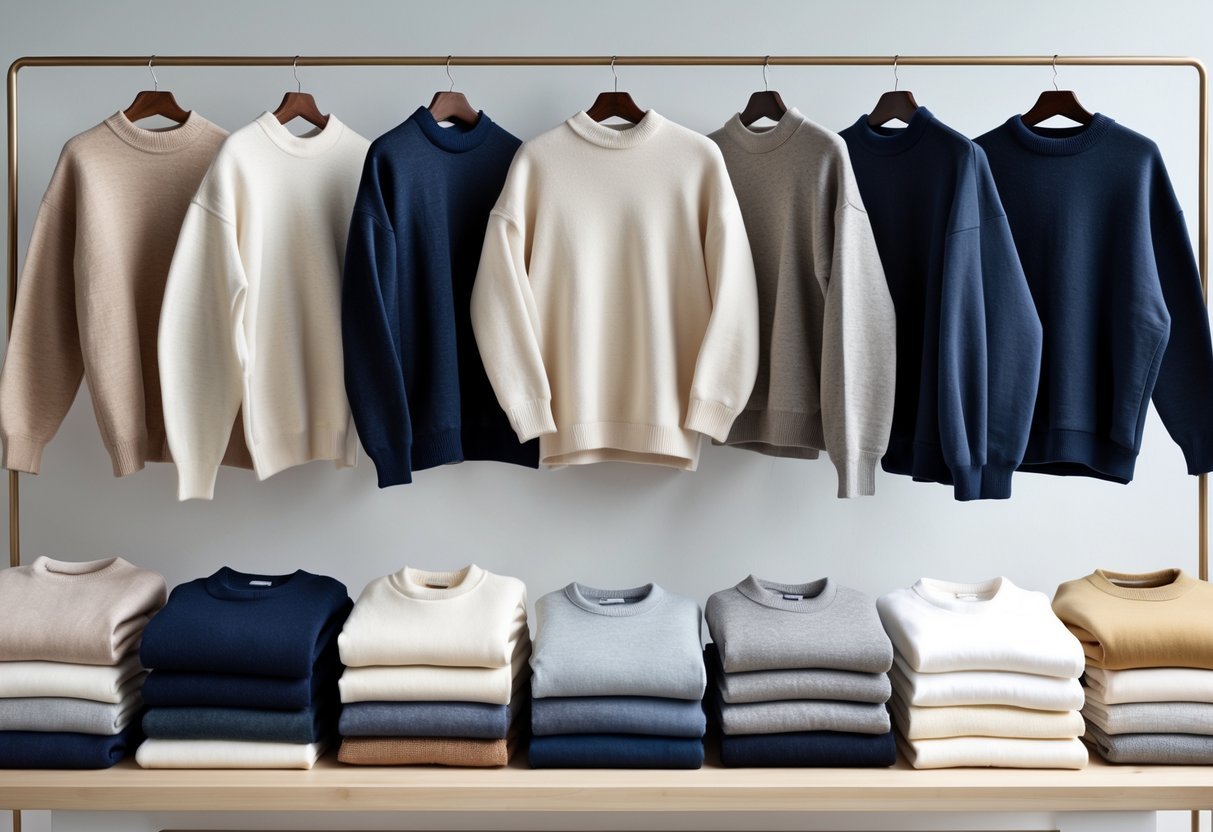
Sweaters often appear in classic styles such as crewneck, V-neck, and turtleneck. These designs offer different necklines and fits to suit various occasions and preferences. Sweaters can also include cardigans that open in the front and provide more layering options.
Sweatshirts usually favor simple styles. The most common are crewneck and hooded versions. Hooded sweatshirts, or hoodies, have a relaxed, casual look and often include pockets and drawstrings.
The differences in style reflect their usual use. Sweaters tend to be more formal or dressy, while sweatshirts are casual and sporty. Both can be comfortable and warm but fit different fashion needs.
8) Layering Use

Sweaters are great for layering under coats when a more polished appearance is needed. They fit well beneath blazers, trench coats, or tailored jackets. This creates a neat and formal look suitable for work or dressier events.
Sweatshirts, on the other hand, are best paired with casual jackets. Their soft and relaxed style matches well with denim or bomber jackets. This combination is comfortable and perfect for everyday wear or informal outings.
Layering a sweater under a structured coat adds warmth without sacrificing style. It also allows for more outfit options by mixing different textures and colors.
A sweatshirt layered under a casual jacket provides cozy comfort and an easygoing vibe. It’s less formal but still stylish and practical for cooler weather.
Both sweaters and sweatshirts offer layering options. The key is choosing the right outerwear to match the intended look—formal sweaters with coats, and casual sweatshirts with laid-back jackets.
9) Temperature Suitability

Sweaters work best in cooler temperatures, usually when it feels chilly but not freezing. They are made from wool, cotton, or other knitted materials that provide warmth without being too heavy.
Sweatshirts are designed for moderate cold. They offer good insulation but are also breathable, making them suitable for activities like jogging or casual outdoor use.
In colder weather, sweaters help keep body heat trapped, making them a good choice for still or low-activity settings.
Sweatshirts, on the other hand, can be layered and are often used in slightly warmer conditions or when people need freedom of movement.
While sweaters focus on warmth and style, sweatshirts balance comfort and function. They are especially helpful for times when the temperature isn’t very low but still cool enough to need some warmth.
10) Texture

Sweaters are made using different knitting techniques, which create a range of textures. The texture can be bumpy, ribbed, or smooth depending on the stitch and yarn used. This variety adds to the look and feel of the sweater.
Sweaters often use natural and synthetic fibers like wool, cotton, acrylic, or cashmere. Each fiber affects the texture. For example, wool tends to feel warm and slightly rough, while cashmere is soft and smooth.
Sweatshirts are made from woven fabrics, often cotton or cotton blends. Their outside surface is usually smooth and flat. Inside, sweatshirts often have a soft lining made from fleece or French terry, which feels cozy against the skin.
This soft lining makes sweatshirts comfortable and warm without the varied surface textures found in sweaters. Sweatshirts usually have a simpler feel compared to the wide texture range in sweaters.
Key Differences Between Sweaters and Sweatshirts

Sweaters and sweatshirts differ mainly in their materials, how they are made, and where people usually wear them. These factors affect comfort, style, and function.
Materials and Fabrics
Sweaters are typically made from knitted yarns like wool, cashmere, or merino wool. These natural fibers provide warmth and can be soft or slightly coarse depending on the quality. Some sweaters use blends to improve durability and softness.
Sweatshirts mostly use cotton or polyester blends. These fabrics are smooth, stretchy, and often heavier because of the fleece lining inside. This makes sweatshirts thicker and better at blocking wind but less breathable than sweaters.
Sweaters usually cost more due to their higher-quality natural fibers. Sweatshirts are generally more affordable since they use common, easy-to-produce materials.
Design and Construction
The design of sweaters involves knitting, which creates a flexible, textured fabric. Sweaters come in many styles like pullovers, cardigans, and turtlenecks. They often have ribbed cuffs and collars for fit and shape.
Sweatshirts are made from woven fabric that is cut and sewn. They usually have a more uniform, smooth surface and a looser fit. Sweatshirts commonly feature a crew neck or hood and may have pockets in the front.
Sweaters are designed to be form-fitting or slightly relaxed, focusing on layering. Sweatshirts lean toward casual wear with sportier, relaxed shapes.
Typical Uses and Occasions
Sweaters are versatile and work for casual, business, and semi-formal occasions. People wear them at work, dinners, or cooler outdoor events. Their materials and styles make them suitable for layering under jackets or on their own.
Sweatshirts are mostly casual and used for leisure, exercise, or cold weather comfort. They are common in sports, home settings, or casual outings. The fleece inside offers warmth for active or relaxed wear but usually isn’t dressed up.
Choosing between a sweater or a sweatshirt depends on the desired look, level of warmth, and occasion type.
Care and Maintenance
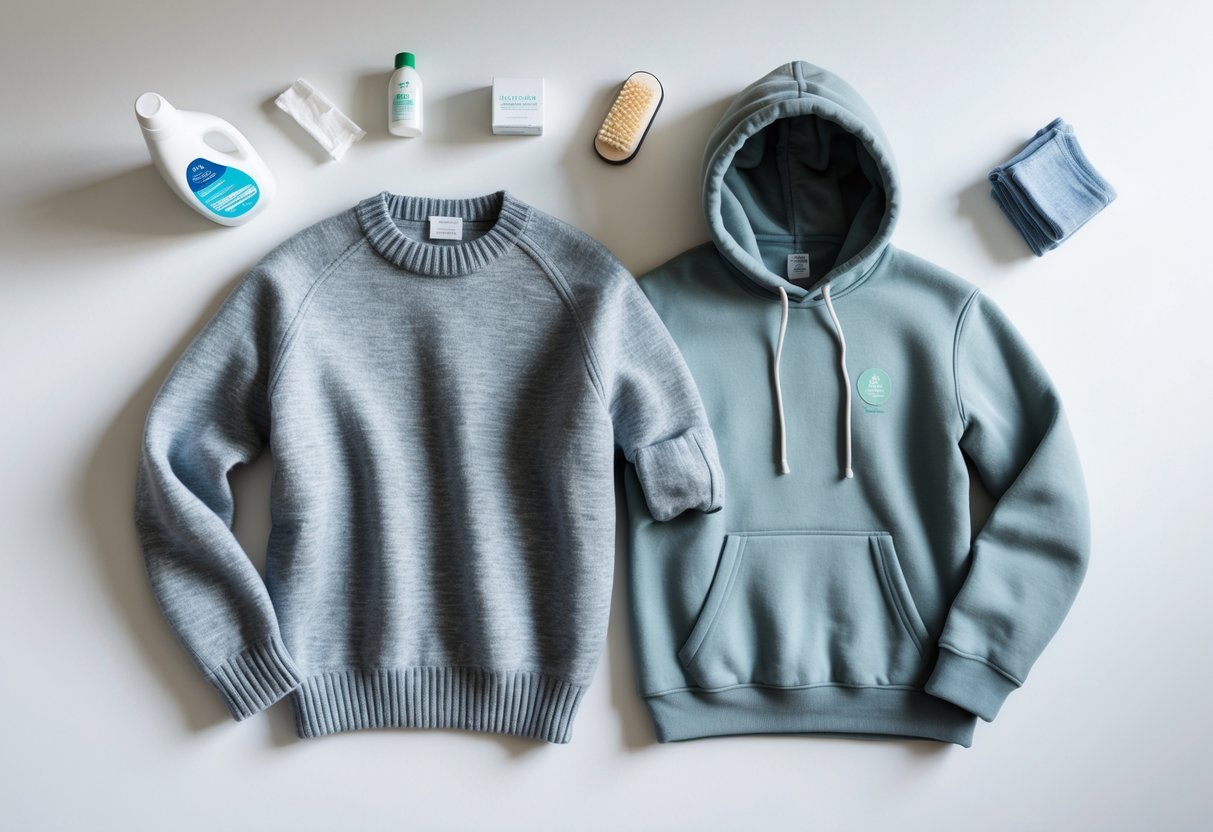
Sweaters and sweatshirts require different care to stay in good condition. Proper washing and storage are important to keep them looking their best and lasting longer.
Washing Guidelines
Sweaters, especially those made of wool or cashmere, need gentle washing. Hand-washing with cold water and mild detergent is best. Machine washing can damage the fibers or change the shape. If using a machine, select a delicate cycle and place the sweater in a mesh laundry bag.
Sweatshirts are easier to wash. Most can be machine washed with cold or warm water on a regular cycle. Use mild detergent and avoid bleach, which can wear down the fabric. Turning sweatshirts inside out helps protect the outer surface.
Drying sweaters flat on a towel keeps their shape safe. Avoid hanging, as this stretches the fabric. Sweatshirts can usually be tumbled dried on low heat but checking the label for specific instructions is important.
Storage Recommendations
Sweaters should be folded and stored in a cool, dry place. Hanging can cause stretching and misshapes. Adding cedar blocks or lavender sachets prevents moth damage and keeps them fresh.
Sweatshirts are more durable and can be folded or hung. Hanging helps keep the shape, but folding works well for saving space. Both garments benefit from breathable storage options, avoiding plastic bags that trap moisture and cause mildew.
Keeping sweaters and sweatshirts clean before storing reduces the risk of stains or odors setting in. Regular airing out helps maintain freshness.
Frequently Asked Questions
This section clarifies key differences in design, materials, and use between sweaters and sweatshirts. It also covers care tips and how style trends apply to each.
What are the defining differences between a sweater and a sweatshirt?
A sweater is usually a knitted garment with a finer fit and a more formal look. A sweatshirt is made with thicker, softer fabric like fleece and has a looser, casual style. Sweaters focus more on warmth, while sweatshirts prioritize comfort.
How do the materials typically used for sweaters compare to those used for sweatshirts?
Sweaters are often made from wool, cotton, or blends of these fibers. Sweatshirts use fleece or jersey fabric, which is softer and designed for casual wear. The fabric choice affects warmth and texture.
Can sweaters be considered more formal than sweatshirts?
Yes, sweaters generally have a more polished and formal appearance. They are suitable for business casual environments. Sweatshirts are seen as casual and sporty, making them less appropriate for formal settings.
What are the best occasions to wear a sweater versus a sweatshirt?
Sweaters are best for occasions where a neat, warm look is needed, like work or gatherings. Sweatshirts are ideal for relaxed activities, exercise, or staying comfortable during downtime.
How should you care for sweaters differently from sweatshirts to maintain their quality?
Sweaters often require gentle hand washing or dry cleaning to avoid shrinking or damaging knit fibers. Sweatshirts are usually machine washable and easier to care for because of their durable fabric.
In terms of fashion trends, how do sweaters and sweatshirts differ?
Sweaters tend to follow classic fashion trends due to their formal and structured style. Sweatshirts often reflect streetwear and casual trends, with bold logos or relaxed fits popular in everyday wear.

